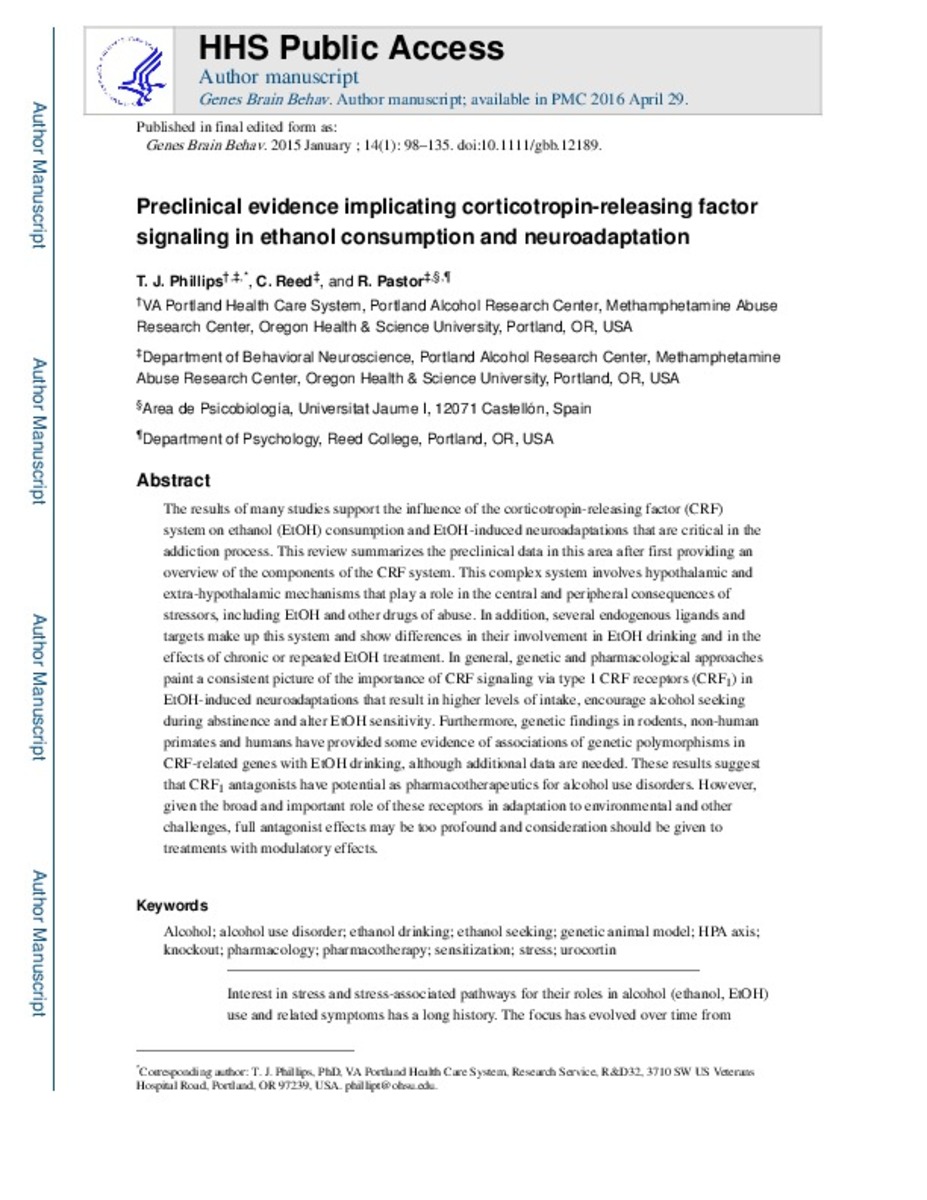Mostrar el registro sencillo del ítem
Preclinical evidence implicating corticotropin-releasing factor signaling in ethanol consumption and neuroadaptation
| dc.contributor.author | Phillips, Tamara J. | |
| dc.contributor.author | Reed, Cheryl | |
| dc.contributor.author | Pastor Medall, Raúl | |
| dc.date.accessioned | 2016-07-27T07:41:55Z | |
| dc.date.available | 2016-07-27T07:41:55Z | |
| dc.date.issued | 2015 | |
| dc.identifier.citation | PHILLIPS, T. J.; REED, C.; PASTOR, R. Preclinical evidence implicating corticotropin‐releasing factor signaling in ethanol consumption and neuroadaptation. Genes, Brain and Behavior, 2015, vol. 14, no 1, p. 98-135. | ca_CA |
| dc.identifier.issn | 1601-1848 | |
| dc.identifier.issn | 1601-183X | |
| dc.identifier.uri | http://hdl.handle.net/10234/161954 | |
| dc.description.abstract | The results of many studies support the influence of the corticotropin-releasing factor (CRF) system on ethanol (EtOH) consumption and EtOH-induced neuroadaptations that are critical in the addiction process. This review summarizes the preclinical data in this area after first providing an overview of the components of the CRF system. This complex system involves hypothalamic and extra-hypothalamic mechanisms that play a role in the central and peripheral consequences of stressors, including EtOH and other drugs of abuse. In addition, several endogenous ligands and targets make up this system and show differences in their involvement in EtOH drinking and in the effects of chronic or repeated EtOH treatment. In general, genetic and pharmacological approaches paint a consistent picture of the importance of CRF signaling via type 1 CRF receptors (CRF1) in EtOH-induced neuroadaptations that result in higher levels of intake, encourage alcohol seeking during abstinence and alter EtOH sensitivity. Furthermore, genetic findings in rodents, non-human primates and humans have provided some evidence of associations of genetic polymorphisms in CRF-related genes with EtOH drinking, although additional data are needed. These results suggest that CRF1 antagonists have potential as pharmacotherapeutics for alcohol use disorders. However, given the broad and important role of these receptors in adaptation to environmental and other challenges, full antagonist effects may be too profound and consideration should be given to treatments with modulatory effects. | ca_CA |
| dc.description.sponsorShip | The authors were supported by the Department of Veterans Affairs; NIH NIAAA grants P60AA010760, R24AA020245 and U01AA013519 and NIH NIDA grant P50DA018165, during the writing of this manuscript. The authors have no financial conflict of interest to disclose. | ca_CA |
| dc.format.extent | 37 p. | ca_CA |
| dc.format.mimetype | application/pdf | ca_CA |
| dc.language.iso | eng | ca_CA |
| dc.publisher | John Wiley & Sons | ca_CA |
| dc.relation.isPartOf | Genes, Brain and Behavior, 2015, vol. 14, no 1 | ca_CA |
| dc.rights | © John Wiley & Sons | ca_CA |
| dc.rights.uri | http://rightsstatements.org/vocab/InC/1.0/ | * |
| dc.subject | alcohol | ca_CA |
| dc.subject | alcohol use disorder | ca_CA |
| dc.subject | ethanol drinking | ca_CA |
| dc.subject | ethanol seeking | ca_CA |
| dc.subject | genetic animal model | ca_CA |
| dc.subject | HPA axis | ca_CA |
| dc.subject | knockout | ca_CA |
| dc.subject | pharmacology | ca_CA |
| dc.subject | pharmacotherapy | ca_CA |
| dc.subject | sensitization | ca_CA |
| dc.subject | stress | ca_CA |
| dc.subject | urocortin | ca_CA |
| dc.title | Preclinical evidence implicating corticotropin-releasing factor signaling in ethanol consumption and neuroadaptation | ca_CA |
| dc.type | info:eu-repo/semantics/article | ca_CA |
| dc.identifier.doi | http://dx.doi.org/10.1111/gbb.12189 | |
| dc.rights.accessRights | info:eu-repo/semantics/openAccess | ca_CA |
| dc.relation.publisherVersion | http://onlinelibrary.wiley.com/doi/10.1111/gbb.12189/full | ca_CA |
| dc.type.version | info:eu-repo/semantics/acceptedVersion | ca_CA |
Ficheros en el ítem
Este ítem aparece en la(s) siguiente(s) colección(ones)
-
PSB_Articles [1293]
Articles de publicacions periòdiques







